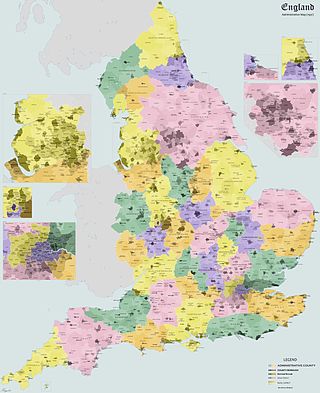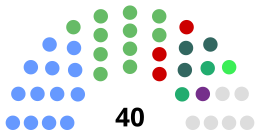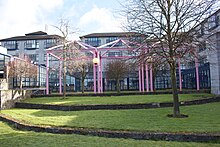
A municipal borough was a type of local government district which existed in England and Wales between 1836 and 1974, in Northern Ireland from 1840 to 1973 and in the Republic of Ireland from 1840 to 2002. Broadly similar structures existed in Scotland from 1833 to 1975 with the reform of royal burghs and creation of police burghs.

Galway City Council is the local authority of the city of Galway, Ireland. As a city council, it is governed by the Local Government Act 2001. The council is responsible for housing and community, roads and transportation, urban planning and development, amenity and culture, and environment. The council has 18 elected members. Elections are held every five years and are by single transferable vote. The head of the council has the title of mayor. The city administration is headed by a Chief Executive, Patricia Philbin. The council meets at City Hall, College Road, Galway.
In Ireland, direct elections by universal suffrage are used for the President, the ceremonial head of state; for Dáil Éireann, the house of representatives of the Oireachtas or parliament; for the European Parliament; and for local government. All elections use proportional representation by means of the single transferable vote (PR-STV) in constituencies returning three or more members, except that the presidential election and by-elections use the single-winner analogue of STV, elsewhere called instant-runoff voting or the alternative vote. Members of Seanad Éireann, the second house of the Oireachtas, are partly nominated, partly indirectly elected, and partly elected by graduates of particular universities.

A local electoral area is an electoral area for elections to local authorities in Ireland. All elections use the single transferable vote. The Republic of Ireland is divided into 166 LEAs, with an average population of 28,700 and average area of 423.3 square kilometres (163.4 sq mi). The boundaries of LEAs are determined by order of the Minister for Housing, Local Government and Heritage, usually based on lower-level units called electoral divisions (EDs), with a total of 3,440 EDs in the state.

The functions of local government in the Republic of Ireland are mostly exercised by thirty-one local authorities, termed County, City, or City and County Councils. The principal decision-making body in each of the thirty-one local authorities is composed of the members of the council, elected by universal franchise in local elections every five years from multi-seat local electoral areas using the single transferable vote. Many of the authorities' statutory functions are, however, the responsibility of ministerially appointed career officials termed Chief executives. The competencies of the city and county councils include planning, transport infrastructure, sanitary services, public safety and the provision of public libraries. Each local authority sends representatives to one of three Regional Assemblies.

Cavan County Council is the authority responsible for local government in County Cavan, Ireland. As a county council, it is governed by the Local Government Act 2001. The council is responsible for housing and community, roads and transportation, urban planning and development, amenity and culture, and environment. The council has 18 elected members. Elections are held every five years and are by single transferable vote. The head of the council has the title of Cathaoirleach (chairperson). The county administration is headed by a Chief Executive, Tommy Ryan. The county town is Cavan.

Louth County Council is the local authority of County Louth, Ireland. As a county council, it is governed by the Local Government Act 2001. The council is responsible for housing and community, roads and transportation, urban planning and development, amenity and culture, and environment. The council has 29 elected members. Elections are held every five years and are by single transferable vote. The head of the council has the title of Cathaoirleach (chairperson). The county administration is headed by a chief executive, Joan Martin. The county town is Dundalk.

Cork County Council is the local authority of County Cork, Ireland. As a county council, it is governed by the Local Government Act 2001, as amended. The council is responsible for housing and community, roads and transportation, urban planning and development, amenity and culture, and environment. The council has 55 elected members. Elections are held every five years and are by single transferable vote. The head of the council has the title of Mayor. The county administration is headed by a Chief Executive, Valerie O'Sullivan. The county seat is Cork.
The office of Mayor of the City and County of Limerick is currently the title used by the chairperson of Limerick City and County Council. Prior to the establishment of the council, the Mayor of Limerick was the chairperson of Limerick City Council. The office was originally established in 1195 and reinforced by a charter issued in 1197. From June 2024, following the 2024 Limerick mayoral election, the Mayor of Limerick will be a directly elected office with a five-year term.

Fingal County Council is the local authority of the county of Fingal, Ireland. It is one of three local authorities that succeeded the former Dublin County Council on abolition on 1 January 1994 and is one of four local authorities in County Dublin. As a county council, it is governed by the Local Government Act 2001. The council is responsible for housing and community, roads and transport, urban planning and development, amenity and culture, and environment. The council has 40 elected members. Elections are held every five years on the electoral system of proportional representation by means of the single transferable vote (PR-STV). The head of the council has the title of Mayor. The county administration is headed by a Chief Executive, AnnMarie Farrelly. The county town is Swords.

South Dublin County Council is the local authority of the county of South Dublin, Ireland. It is one of three local authorities created by the Local Government (Dublin) Act 1993 to succeed the former Dublin County Council before its abolition on 1 January 1994 and one of four councils in County Dublin. As a county council, it is governed by the Local Government Act 2001. The council is responsible for housing and community, roads and transportation, urban planning and development, amenity and culture, and environment. The council has 40 elected members. Elections are held every five years and are by single transferable vote. The head of the council has the title of Mayor. The county administration is headed by a Chief Executive, Daniel McLoughlin. The county town is Tallaght, with a civic centre at Monastery Road, Clondalkin. It serves a population of approximately 192,000.

Tipperary County Council is the local authority of County Tipperary, Ireland. As a county council, it is governed by the Local Government Act 2001. The council is responsible for housing and community, roads and transportation, urban planning and development, amenity and culture, and environment. The council has 40 elected members. Elections are held every five years and are by single transferable vote. The head of the council has the title of Cathaoirleach (chairperson). The county administration is headed by a Chief Executive, Joe MacGrath. The administrative centres are Nenagh and Clonmel.

The Local Government Reform Act 2014 is an act of the Oireachtas which provided for a major restructuring of local government in Ireland with effect from the 2014 local elections. It merged some first-tier county and city councils, abolished all second-tier town and borough councils, and created a new second tier of municipal districts covering rural as well as urban areas. It also provided for a plebiscite on whether to create a directly elected executive Mayor of the Dublin Metropolitan Area although this provision was not activated. The act was introduced as a bill on 15 October 2013 by Phil Hogan, the Minister for the Environment, Community and Local Government, and signed into law on 27 January 2014 by President Michael D. Higgins. Most of its provisions came into force on 1 June 2014.
There have been several proposals for a directly elected mayor of the Dublin metropolitan area in Ireland. The area corresponds to County Dublin, and comprises four local authority areas, namely the city of Dublin and the counties of South Dublin, Fingal, and Dún Laoghaire–Rathdown. Currently, the elected councillors of each local authority area choose a chairperson or mayor annually from among their number as a ceremonial head with no extra powers. The chairperson of Dublin City Council is the Lord Mayor of Dublin, a ceremonial position separate from the proposed executive mayor. This is similar to the distinction between the ancient office of Lord Mayor of London and the office of Mayor of London established in 2000.

The 2019 Irish local elections were held in all local authorities in Ireland on Friday, 24 May 2019, on the same day as the 2019 European Parliament election and a referendum easing restrictions on divorce. Each local government area is divided into local electoral areas (LEAs) where three to seven councillors are elected on the electoral system of proportional representation by means of the single transferable vote.

An election to all 40 seats on Limerick City and County Council was held on 24 May 2019 as part of the 2019 Irish local elections. Limerick City and County was divided into 6 local electoral areas (LEAs) to elect 40 councillors for a five-year term of office on the electoral system of proportional representation by means of the single transferable vote (PR-STV).

An election to all 32 seats on Waterford City and County Council was held on 24 May 2019 as part of the 2019 Irish local elections. The City and County of Waterford was divided into 6 local electoral areas (LEAs) to elect councillors for a five-year term of office on the electoral system of proportional representation by means of the single transferable vote (PR-STV).
Local government in Dublin, the capital city of Ireland, is currently administered through the local authorities of four local government areas. The historical development of these councils dates back to medieval times.
An election to decide the first directly elected Mayor of Limerick has been set for 7 June 2024, as part of the 2024 Irish local elections. Limerick is the first local authority in Ireland to have directly elected mayor, following a plebiscite held at the previous council election. The election will be held under the Local Government and Miscellaneous Provisions Act 2024. Candidates can be nominated by a registered political party or with the support of 60 electors.

















